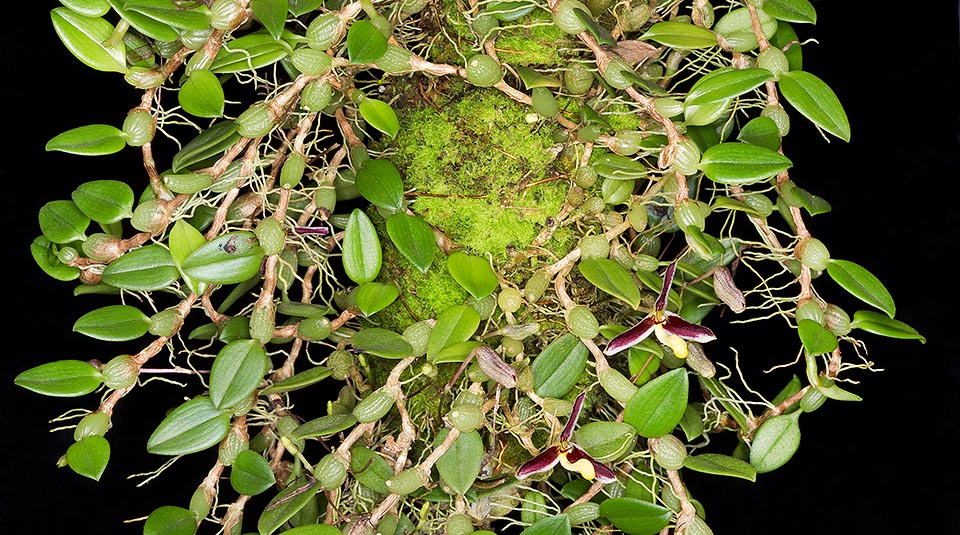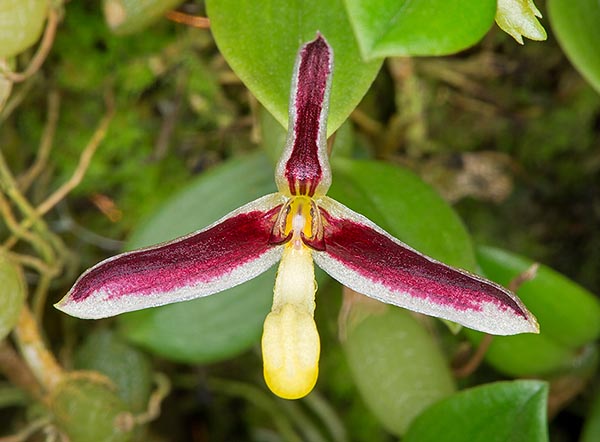Family : Orchidaceae

Text © Pietro Puccio

English translation by Mario Beltramini

Native to Moluccas and New Guinea, Bulbophyllum alkmaarense is a small epiphyte of the humid forests at medium altitudes. Several ovoid pseudobulbs, about 0,4-0,7 cm long, each with only one oblong-elliptic 1,1-2,5 cm leaf. They develop from the long and intricate creeping rhizomes developping thin roots at the nodes © G. Mazza
The species is native to Moluccas and New Guinea where it grows on the trees of the humid forests at medium altitudes.
The name of the genus is the combination of the Greek substantives “βολβός” (bolbos) = bulb and “φύλλον” (phyllon) = leaf, with refrence to the leaves growing at the apex of the pseudobulbs; the specific name is the Latin adjective “alkmaarensis” = of Alkmaar, with reference to the name given to the camp of the Lorentz scientific expedition (1907) in New Guinea whare has been found the type species (Alkmaar is a city of northern Holland).
The Bulbophyllum alkmaarense J.J.Sm. (1911) is an epiphytic species with slightly depressed ovoid pseudobulbs, 0,4-0,7 cm long, on a creeping rhizome rooting at the nodes with thin roots, provided at the apex of an oblong-elliptic leaf, 1,1-2,5 cm long and 0,4-0,6 cm broad, coriaceous, of intense green colour and glossy above.

Species rare in cultivation with solitary flowers of about 2,3 cm of diameter © Giuseppe Mazza
Solitary flowers from the base of the pseudobulb, on pedicle of 1,6 cm long, of about 2,3 cm of diameter, with linear sepals having pointed apex, about 1,4 cm long, of purple colour with white margin, oblong petals with obtuse apex, falcate, 0,3-0,4 cm long, and linear labellum, sigmoidal, with curved margins, about 0,9 cm long, of yellow colour.
It reproduces by seed, in vitro, and by division, with each section provided of at least 3-4 pseudobulbs.
Miniature orchid rare in cultivation, requires semi-shaded position, medium-high temperatures in summer, 18-30 °C, slightly cooler in winter, with lowest night values not under the 12 °C, high humidity, 80-85%, and always moving air. Frequent waterings and nebulizations from spring to autumn, slightly more spaced in winter, but without ever allowing the substratum to dry up completely, having no resting period, utilizing rain water, demineralized or by reverse osmosis. Weekly fertilizations from spring to autumn utilizing a hydrosoluble balanced product, with microelements, at ¼ the dosage suggested on the package. It is usually mounted on trunks, bark, cork or arborescent ferns rafts, to allow the pseudobulbs to freely expand, possibly with some sphagnum at the base to maintain the humidity if the ambient of cultivation is quite dry. Possible transplants are to be done, when strictly necessary, at the vegetative restart.
The species is reported in the appendix II of CITES (species whose trade is internationally ruled).
Synonyms: Bulbophyllum jadunae Schltr. (1912); Bulbophyllum jensenii J.J.Sm. (1926); Hapalochilus alkmaarensis (J.J.Sm.) Garay & W.Kittr. (1986); Hapalochilus jadunae (Schltr.) Garay & W.Kittr. (1986); Hapalochilus jensenii (J.J.Sm.) Garay & W.Kittr. (1986).
